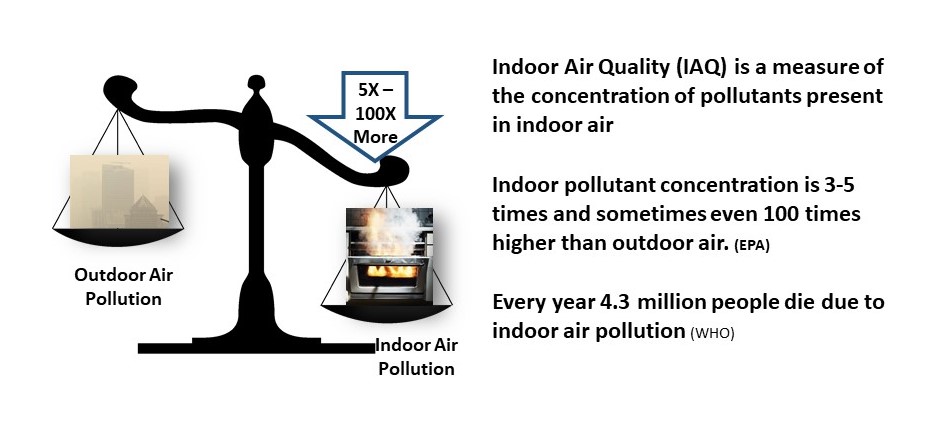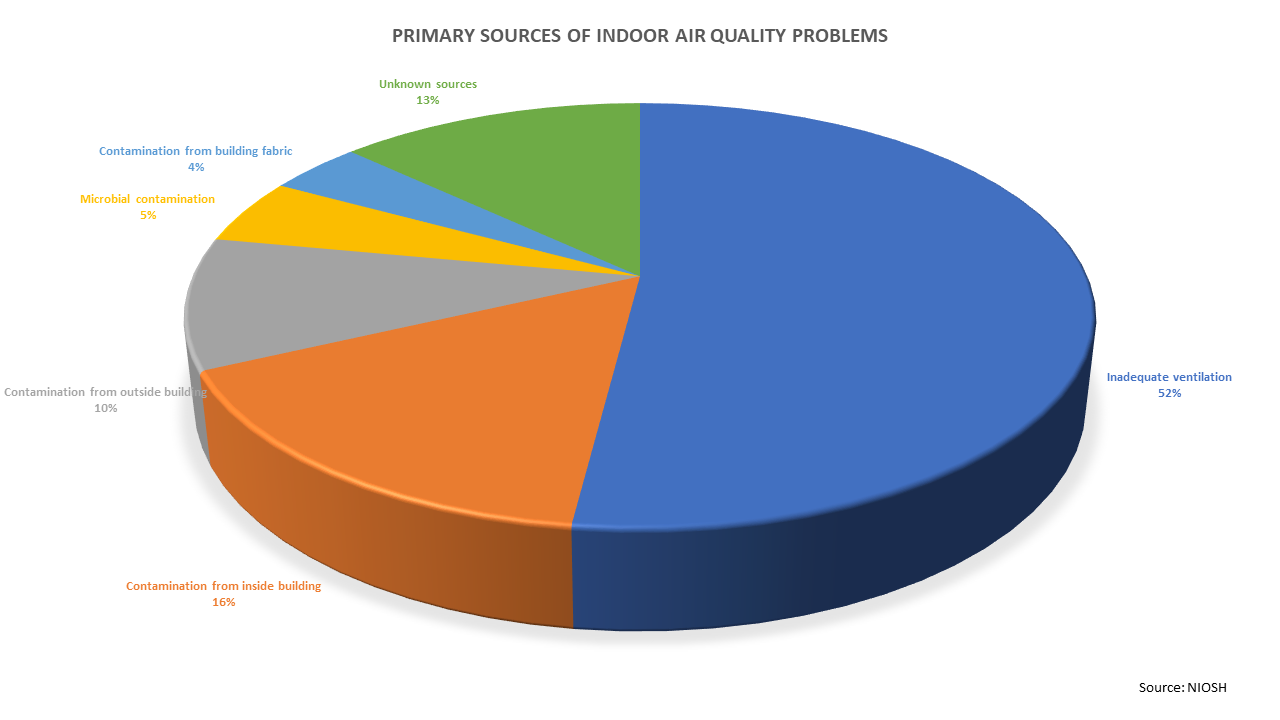Indoor Air Quality Matters!
IAQ impacts our Health, Well-being, and Productivity Significantly!

Most people spend about 75% of their time indoors (Leech et al.)
Americans, on average, spend approximately 90 percent of their time indoors (EPA)
Turnkey Solutions
Given that we spend most of our time indoors, and the indoor air is more polluted than outdoor air; IAQ clearly has a significant impact on our life, then why is IAQ the most ignored problem?
Given that we spend most of our time indoors, and the indoor air is more polluted than outdoor air; IAQ clearly has a significant impact on our life, then why is IAQ the most ignored problem?
- Pollutants are invisible: Most indoor pollutants are colorless, odorless, and tasteless. Sometimes we experience no symptoms for years after exposure to indoor pollutants. This results in lack of awareness and underestimation of the risks.
- Breathing is an involuntary act: Human volition is essentially ineffective when it comes to managing exposure to air pollutants. We have very limited control in deciding how we are going to breathe and invariably the quality of air determines our health. We cannot wait for clean air to take our next breath.
- Behavioral Biases: We believe that that we are secure within our homes, and thus we are more likely to underestimate the risk from indoor air pollution. We like to keep our windows closed for safety, privacy, and thermal efficiency; this results in poor ventilation and poor IAQ.
- Ingrained Cultural Preferences: Fresh paint and new furniture for the baby’s room just before a baby's birth is a very common tradition; most of us are not aware that this results in poor IAQ and can impact the health of the baby and mother.
- Economic Trade-off: Quest for thermal efficiency and low energy costs has led to the construction of airtight buildings; this has choked the natural airflow of the buildings and resulted in poor ventilation and poor IAQ.
The solution lies not in ignoring but in becoming aware of and in resolving the problem. We can celebrate the birth of a new baby by renovating the nursery with paints and new furniture but we should be mindful that we keep the IAQ healthy by following a few steps! But before we jump to solutions let's look at the factors responsible for poor IAQ
In approximately 500 indoor air quality investigations in the last decade, the National Institute for Occupational Safety and Health (NIOSH) identified the primary issues responsible for indoor air quality problems


(Source: https://www.epa.gov)
- This is invisible enemy number # 1!
- These particles are small and light, which allows them to stay in the atmosphere for longer periods of time.
- Humans have no natural defences against PM2.5 and their infinitesimal size allows them to bypass the filters of nose and throat.
- PM2.5 can penetrate into the lungs and even the circulatory system very quickly [1].
- PM2.5 have been associated with 4% to 8% increases in cardiopulmonary diseases and lung cancer [2].
- It is best to keep indoor levels of PM2.5 as low as possible, as there is no apparent threshold for the health effects of PM2.5.
- It is not possible to entirely eliminate PM2.5 indoors.
- Essential and everyday activities, such as cooking and cleaning, are a source of particulate matter.
- There is also infiltration of PM2.5 from outdoor sources.
The main recommended strategies to reduce exposure to the major sources of indoor-generated PM2.5 are:
- Stop smoking indoors
- Use a stove top exhaust fan while cooking
- Ensure that there is adequate ventilation, especially when doing activities that may generate PM2.5
- Use AirNow to help monitor and protect yourself and your family from elevated PM levels before opening windows and doors
- Filter out all that visible and invisible particulate matter.
While a number of solutions are available, for some a DIY solution might be the best option. Jeffrey E. Terrell, M.D., director of the University of Michigan Health System’s Michigan Sinus Center offers a do-it-yourself solution at a fraction of the cost. Jeffrey E. Terrell, M.D., director of the University of Michigan Health System’s youtube video
There are a large number of air filtration choices can do a reasonable job of filtering out the particulate matter and allergens. EPA provides a useful guide that can be used as a ready reference. EPA guide to Air Cleaners
You can also look at this link before buying air purifiers: California Government Research on Certified Air Cleaners
You can look at this link before buying air filters: California Government Research
References
- [1] K. Yang et al. “Urban air pollution study based on GIS”. In: 2009 Joint Urban Remote Sensing Event. May 2009
- [2] Pope III C et al. “Lung cancer, cardiopulmonary mortality, and long-term exposure to fine particulate air pollution”
- [3] Guerreiro, Cristina. "Air quality in Europe: 2013 report." (2013)
- [4]Canada Health Guidance on PM2.5
Coarse particles (PM10-2.5) are of less concern, although they can irritate a person's eyes, nose, and throat. (EPA)
More Vulnerable Sectors are
:- People with heart and lung diseases such as coronary artery disease, congestive heart failure, and asthma or chronic obstructive pulmonary disease (COPD), are more vulnerable because PM can aggravate these diseases. (EPA)
- Senior Citizens: Many studies show that when particle levels are high, older adults are more likely to be hospitalized, and some may even die of aggravated heart or lung disease (EPA)
- Infants and Young Children: Their lungs are still developing; children spend more time at higher activity levels; and both these factors make them more vulnerable to PM (EPA)
- Pregnant Woman: scientists are evaluating new studies that suggest that exposure to high particle levels may also be associated with low birth weight in infants, pre-term deliveries, and possibly fetal and infant deaths (EPA)
- Volatile organic compounds include trichloroethylene, benzene, toluene, methyl ethyl ketone, alcohols, methacrylates, polycyclic aromatic hydrocarbons, and pesticides.
Sources
:- Paints, paint strippers, cleaning compounds, varnishes and finishes, silicone caulking materials, moth-balls, adhesives, Flooring, carpet, pressed wood products, furniture, pesticides, disinfectants, Air freshners, Arts and crafts products: glues, permanent markers, etc., photocopiers, "spirit" duplicators, signature machines, insecticides, herbicides, combustion products, asphalt, Fuel, oil, gasoline vapors, dried out floor drains, cosmetics and other personal products, tobacco smoke, wood burning stoves etc.
Acute health effects
:- Nausea; dizziness; eye, respiratory tract, and mucous membrane irritation; headache; fatigue, and some VOCs can damage the central nervous system as well as other organs. Some VOCs like formaldehyde can cause cancer.
- Details on specific health effects of each specific VOC can be found in The Agency for Toxic Substances and Disease Registry Toxic Substances Portal.
Protecting yourself from VOCs (American Lung Association)
:- Avoid or limit the use of products with high VOCs
- Use products that are low in VOCs, including some sources like paints and building supplies. Look for "Low VOCs" information on the label.
- Buy only as much as you need for the project. Dispose off any leftover or unused products safely.
- Always follow manufacturers' directions when using these products.
- Add ventilation when you use products with VOCs indoors
- Open windows and add a fan to pull the indoor air outside while you're using products with high VOCs.
- Increasing the amount of fresh air in your home will help reduce the concentration of VOCs indoors.
- Let new carpet or new building products air outside to release VOCs before installing them.
- Don't store products with VOCs indoors, including in garages connected to the building.
- Make sure your office or school ventilation systems are working effectively to reduce VOCs produced by printers or copiers
- Don't smoke and keep all buildings smokefree. Tobacco smoke contains VOCs among other carcinogens.
- Formaldehyde is a colorless and flammable gas with a distinct odor detectable at very low concentrations.
- Formaldehyde levels are usually much higher indoors.
- Formaldehyde is volatile, it evaporates easily, and it is released into the air from many products inside the home.
- High humidity and high temperatures speed up the release of formaldehyde.
Sources
:- Indoor sources may be combustion processes such as smoking, heating, cooking, or candle or incense burning.
- Major sources in non-smoking environments appear to be building materials and consumer products that emit formaldehyde.
- This applies to new materials and products but can last several months, particularly in conditions with high relative humidity and high indoor temperatures.
- Formaldehyde sources in indoor environments include: furniture and wooden products containing formaldehyde-based resins such as particleboard, plywood and medium-density fibreboard; insulating materials (in the early 1980s, urea formaldehyde foam insulation was a major source of indoor pollution); textiles; do-it-yourself products such as paints, wallpapers, glues, adhesives, varnishes and lacquers; household cleaning products such as detergents, disinfectants, softeners, carpet cleaners and shoe products; cosmetics such as liquid soaps, shampoos, nail varnishes and nail hardeners; electronic equipment, including computers and photocopiers; and other consumer items such as insecticides and paper products. (source:WHO)
Acute health effects
:- Hypersensitive or allergic reactions; skin rashes; eye, respiratory and mucous membrane irritation; odor annoyance.
- Other short-term effects include headache, runny nose, nausea and difficulty breathing.
- Exposure may cause wheezing, asthma attacks and other respiratory symptoms.
- Researchers have found that some individuals with asthma are more vulnerable to the effects of inhaled formaldehyde.
- At high concentration formaldehyde causes cancer.
There are a few simple ways to protect yourself from formaldehyde indoors. (American Lung Association)
- Choose low-formaldehyde products when building or remodeling.
- Furniture and pressed-wood board made with laminated surfaces release less formaldehyde and other VOCs.
- If possible, use non-toxic alternatives to formaldehyde-containing products like glue and adhesives.
- Ventilate indoor spaces. Open windows or use exhaust fans to blow indoor air out and bring fresh air in.
- Make sure any combustion appliance has a separate exhaust to the outdoors.
- Remember to ventilate indoor spaces when using cleaners, cosmetic products like nail polish remover or most paints.
- Air out new furniture and pressed-wood products.
- Many consumer products that emit formaldehyde, such as plywood and particle board, release the highest concentrations when they are new. Air them out before installing them or bringing them indoors.
- Don't allow smoking indoors. Not smoking and prohibiting smoking indoors can reduce exposure to formaldehyde. Secondhand smoke contains many chemicals in addition to formaldehyde that can harm health.
- Wash permanent press clothing before wearing. Formaldehyde is used in the production of special fabrics.
References
- Agency for Toxic Substances and Disease Registry (ATSDR). Tox FAQs for Formaldehyde. Atlanta, GA: U.S. Department of Health and Human Services, Public Health Service. 2011. Accessed August 26, 2015.
- California Air Resources Board (CARB). Report to the California Legislature: Indoor Air Pollution in California. Sacramento, CA: California Environmental Protection Agency. 2005.
- Agency for Toxic Substances and Disease Registry (ATSDR). Revised Health Consultation –Formaldehyde Sampling at FEMA Temporary Housing Units - Baton Rouge, Louisiana. Atlanta, GA: U.S. Department of Health and Human Services, Public Health Service. 2007.
- Institute of Medicine, Division of Health Promotion, Indoor Air and Disease Prevention. Clearing the Air: Asthma and Indoor Air Exposures. Washington, DC: National Academies Press. 2000; Kanchongkittiphon W, et al. Indoor Environmental Exposures of Asthma: An Update to the 2000 Review by the Institute of Medicine. Environmental Health Perspectives. 2015; 123: 6-20.
Sources
- Acrolein is also emitted from materials which emit formaldehyde;
- High acrolein concentrations were also found in newly built, uninhabited homes and in emissions from lumber commonly used in home construction, suggesting indoor contributions from off-gassing and/or secondary formation.
- Cooking is also a potentially significant indoor source.
- Homes with frequent, regular cooking activity had the highest baseline (morning) acrolein levels.
- The results provide strong evidence that human exposure to acrolein is dominated by indoor air with little contribution from ambient outdoor air.
Cumulative health impacts from inhalation in U.S. residences of the IAPs assessed in Seaman's study are estimated at 400–1,100 DALYs lost annually per 100,000 persons.
- For 80% of the Monte Carlo samples, indoor PM2.5 was associated with the largest number of DALY losses
- For 90% of the samples, acrolein, formaldehyde, and PM2.5 contributed > 80% of the total DALYs lost.
References
- Seaman VY1, Bennett DH, Cahill TM. Origin, occurrence, and source emission rate of acrolein in residential indoor air.
- A Method to Estimate the Chronic Health Impact of Air Pollutants in U.S. Residences
- Carbon dioxide is a gas we breathe out. Indoors with large number of people and poor ventilation results in high CO2 levels. Higher levels of CO2 impacts our ability to think coherently and adversely impacts our productivity.
Sources:
- Unvented gas and kerosene appliances, improperly vented devices, processes or operations which produce combustion products, human respiration.
Acute health effects:
- Drowsiness, increased respiration rate, slow performance, fatigue, difficulty concentrating, impairs executive function, and lowers performance.
Carbon monoxide (CO) is an odorless, colorless, and tasteless but dangerous gas. Breathing CO reduces the blood's ability to carry oxygen.
Sources
- Tobacco smoke, fossil-fuel engine exhausts, improperly vented fossil-fuel appliances.
Health Effects
- Breathing CO at low levels regularly may cause permanent mental or physical problems.
- Breathing higher levels of CO causes sleepiness, dizziness, weakness, headache, nausea, anxiety or depression, vomiting, confusion, impaired vision, impaired coordination, disorientation, cyanosis, and cardiovascular effects in healthy people.
-
At very high levels, it causes loss of consciousness and death.2 Approximately 430 people die each year from CO exposure related to fuel-burning, residential appliances. Thousands more became ill or sought medical attention.3 CO poisoning is estimated to cause more than 50,000 emergency room visits in the United States each year.2
How can you protect yourself from carbon monoxide?
- Many people are poisoned by CO after bad weather emergencies, like snowstorms and hurricanes.
- Make sure appliances are installed and working according to manufacturers' instructions and local building codes.
- make sure all appliances are fully vented to the outdoors.
- Have the heating system, chimney and flue inspected and cleaned by a qualified technician every year.
- Make sure your furnace has an adequate intake of outside air.
- Use appliances and stoves appropriately
- Do not use ovens and gas ranges to heat your home.
- Do not burn charcoal, kerosene lanterns or portable camp stoves inside a home, cabin, recreational vehicle or camper.
- Do not operate gasoline-powered engines in confined areas such as garages or basements.
- Never leave your car or mower running in a closed garage.
- If you must use a portable generator in an emergency, keep it as far away from your home as possible and away from windows or doors.
- Do not smoke inside your home. Cigarettes, pipes and cigars also produce carbon monoxide.
- Install a CO detector with an audible alarm near sleeping areas, on indoor walls shared with a garage, and near combustion equipment in your home.
References
- Raub JA, Matheieu-Nolf M, Hampson NB, Thom SR. Carbon Monoxide Poisoning—A Public Health Perspective. 2000. Toxicology 145: 1-14.
- Weaver LK. Carbon Monoxide Poisoning. 2009. New England Journal of Medicine 360: 1217-1225.
- Centers for Disease Control and Prevention. QuickStats: Average Annual Number of Deaths and Death Rates from Unintentional, Non–Fire-Related Carbon Monoxide Poisoning,*† by Sex and Age Group — United States, 1999–2010. Morbidity and Mortality Weekly Report (January 24, 2014) 63(03):65.
- U.S. EPA. 2010 Final Assessment: Integrated Science Assessment for Carbon Monoxide. U.S. Environmental Protection Agency, Washington, DC, EPA/600/R-09/019F, 2010.
- American Lung Association
- IAQ is affected by cooking, smoking, cleaning products and processes, painting, interior finishes, personal-care products, pesticides, pet dander, mold, exterior pollutants etc.
- Human health can be adversely affected by a number of conditions in built environments, from materials and techniques used in the construction process, from activities within those spaces, and from connections to the external environment.
- Some groups, including children, pregnant women, and limited-resource households, are at a higher risk than others for experiencing negative health impacts from indoor pollutant exposures. Limited-resource households, in particular, do not have resources necessary to test for the presence of indoor air pollutants and to mitigate them.
- References
- [1] Lomborg, 2014
- [2] World Health Organization 2014
- [3] Leech and Smith-Doiron 2006
- [4] Environmental Protection Agency (EPA)

